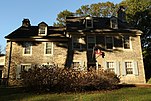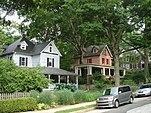Lansdale/Doylestown Line
| Lansdale/Doylestown Line | |||
|---|---|---|---|
 Jenkintown-Wyncote station, a major stop on the Lansdale/Doylestown line | |||
| Overview | |||
| Status | Operating | ||
| Termini | |||
| Stations | 27 | ||
| Website | septa.org | ||
| Service | |||
| Type | Commuter rail line | ||
| System | SEPTA | ||
| Operator(s) | SEPTA Regional Rail | ||
| Rolling stock | Electric Multiple Units | ||
| Daily ridership | 16,267[1] | ||
| Technical | |||
| Track gauge | 4 ft 8+1⁄2 in (1,435 mm) standard gauge | ||
| Electrification | Catenary | ||
| |||
The Lansdale/Doylestown Line is a SEPTA Regional Rail line connecting Center City Philadelphia to Doylestown in Bucks County, Pennsylvania.
History
This section possibly contains original research. (September 2010) |
The Lansdale-Doylestown line utilizes what is known as the SEPTA Main Line, a four-track line that has been owned by SEPTA since 1983 (prior to that, by Conrail between 1976 and 1983 and by the Reading Railroad before 1976), and the former Reading Railroad (RDG) Doylestown Branch. Historically, the main part of the line, from Philadelphia north to Lansdale, was part of the Reading Railroad's route from Philadelphia to Bethlehem, and then to Wilkes-Barre and Scranton.

Originally arriving and departing at the former Reading Terminal, now part of the Pennsylvania Convention Center, the line has, since 1985, been directly connected to the ex-PRR/Penn Central side by the Center City Commuter Rail Tunnel. Unlike the ex-PRR/Penn Central Paoli/Thorndale Line it is often paired with for through-service, the ex-RDG line was not as heavily built, as the RDG segregated its through-freight and passenger movements. While the four-track section between the tunnel and Wayne Junction and the two-track section from Wayne Junction to Jenkintown are grade-separated, the two-track section from Jenkintown to Lansdale and the single track from Lansdale to Doylestown has both at-grade railroad crossings and over- and underpasses.[2]
Electrified service between Philadelphia and Hatboro, Lansdale, Doylestown and West Trenton was opened on July 26, 1931. Equipment consisted of dark green painted electric multiple unit cars built at the Reading's own shops. Some of the cars were rebuilt during the 1960s receiving air conditioning, refreshed interior and a new blue paint scheme resulting in their being referred to as "Blueliners". Today, the line uses the Silverliner family of EMU cars which operate throughout SEPTA's Regional Rail system.[2]
Service to Bethlehem and the Lehigh Valley languished due to the post-World War II surge of the automobile as well as the opening of the Pennsylvania Turnpike Northeast Extension in 1957. Service north of Lansdale in the non-electrified territory was terminated by SEPTA on July 29, 1981.[2] Trackage north of Quakertown was dismantled after the railbed was leased for use as the interim Saucon Rail Trail.

On August 29, 2011, SEPTA adjusted the midday service pattern to encourage ridership at Colmar station, which had available parking capacity immediately adjacent to Pennsylvania Route 309. Previously, every other train turned back at Lansdale; those trains now call at Colmar before terminating at Link Belt, providing half-hourly service at Colmar between the morning and afternoon rush hours.[3]
On December 18, 2011, SEPTA eliminated weekend service at Link Belt and New Britain due to low ridership.
A large parking garage is to be built at Lansdale station. 9th Street station opened nearby on November 15, 2015 as an alternate parking location during construction; it will remain open afterwards to as part of planned transit-oriented development.[4]
Name change


On July 25, 2010 SEPTA renamed the service from the R5 Lansdale/Doylestown to simply the Lansdale/Doylestown Line as part of system-wide service change that drops the R-number naming.[5]
Station list
All stations have low level platforms unless otherwise noted
| Zone | Milepost | Station | Boardings[6] | City/Township | County | Notes |
|---|---|---|---|---|---|---|
| C | 2.1 | Temple University | 3,028 | Philadelphia | Philadelphia | boardings include all lines; high level platforms |
| 1 | 2.9 | North Broad | 103 | boardings include Warminster Line and Manayunk/Norristown Line; low level platforms with mini-high-level platforms | ||
| 5.1 | Wayne Junction | 527 | boardings include Warminster Line, West Trenton Line, Chestnut Hill East Line, and Fox Chase Line; high-level platforms | |||
| 7.3 | Fern Rock Transportation Center | 825 | boardings include Warminster Line and West Trenton Line; high-level platforms | |||
| 2 | 8.4 | Melrose Park | 458 | Cheltenham | Montgomery | boardings include Warminster Line and West Trenton Line; high-level platforms |
| 9.2 | Elkins Park | 632 | boardings include Warminster Line and West Trenton Line; upgrade to high-level platforms planned | |||
| 3 | 10.8 | Jenkintown-Wyncote | 1,998 | Cheltenham/Jenkintown | boardings include Warminster Line and West Trenton Line; upgrade to high-level platforms planned Aerial photo | |
| 11.9 | Glenside | 1,064 | Cheltenham | boardings include Warminster Line; | ||
| 13.0 | North Hills | 202 | Abington | |||
| 13.9 | Oreland | 276 | Springfield | |||
| 15.9 | Fort Washington | 1,108 | Whitemarsh | high-level platforms | ||
| 17.3 | Ambler | 1,017 | Ambler | high-level platforms | ||
| 18.8 | Penllyn | 216 | Lower Gwynedd | |||
| 20.0 | Gwynedd Valley | 210 | ||||
| 4 | 22.4 | North Wales | 790 | North Wales | high-level platforms | |
| 23.5 | Pennbrook | 467 | Lansdale | |||
| 24.4 | Lansdale | 1,396 | Approximately half of Lansdale/Doylestown trains terminate here | |||
| 25.0 | 9th Street | high-level platforms; opened on November 15, 2015[4] | ||||
| 25.9 | Fortuna | 60 | Hatfield | upgrade to a high-level platform planned | ||
| 26.8 | Colmar | 370 | high-level platform | |||
| 27.5 | Link Belt | 46 | high-level platform | |||
| 29.7 | Chalfont | 136 | Chalfont | Bucks | high-level platform | |
| 31.5 | New Britain | 51 | New Britain | high-level platform | ||
| 32.8 | Delaware Valley College | 68 | Doylestown Township | high-level platform | ||
| 34.4 | Doylestown | 383 | Doylestown |
Ridership
| Fiscal year | Average weekday | Annual passengers |
|---|---|---|
| FY 2014 | 16,267 | 4,636,214[7] |
| FY 2013 | 16,343 | 4,657,647[8] |
| FY 2012 | 16,429 | 4,682,402[9] |
| FY 2011 | 14,980 | 4,269,160[10] |
| FY 2010 | 15,487 | 4,385,929[11] |
| FY 2009 | 16,560 | 4,689,753[12] |
| FY 2008 | 16,285 | 4,611,900[13] |
| FY 2005 | 13,490 | 3,808,662 |
| FY 2004 | 13,361 | 3,750,404 |
| FY 2003 | 14,130 | 3,563,400 |
| FY 2001 | n/a | 3,492,000 |
| FY 2000 | n/a | 3,830,000 |
| FY 1999 | n/a | 3,162,000 |
| FY 1997 | n/a | 3,150,497 |
| FY 1996 | n/a | 3,105,782 |
| FY 1995 | 10,762 | 2,982,735 |
| FY 1994 | 9,821 | 2,485,290 |
| FY 1993 | 9,177 | 2,211,611 |
| Note: n/a = not available | ||
References
- ^ "Fiscal Year 2016 Annual Service Plan. p. 98" (PDF). SEPTA. June 2015.
- ^ a b c Williams, Gerry (1998). Trains, Trolleys and Transit: A Guide to Philadelphia Area Rail Transit. Piscataway, New Jersey: Railpace Company, Inc. pp. 80–83. ISBN 0-9621541-7-2.
{{cite book}}: Cite has empty unknown parameter:|coauthors=(help) - ^ "SEPTA adds more Colmar stops". September 1, 2011. Retrieved December 11, 2011.
- ^ a b "9th Street Station". Southeastern Pennsylvania Transportation Authority. Retrieved 1 November 2015.
- ^ "List of new SEPTA schedules".
- ^ "Fiscal Year 2015 Annual Service Plan" (PDF). SEPTA. May 2014.
- ^ Template:PDFlink
- ^ Template:PDFlink
- ^ Template:PDFlink
- ^ Template:PDFlink
- ^ http://www.septa.org/reports/pdf/asp12.pdf
- ^ http://www.septa.org/reports/pdf/asp11.pdf
- ^ http://www.septa.org/reports/pdf/asp10.pdf




